


















ere are just a few of many useful news items and positive stories for you to enjoy in this issue.
Our cover story on facial cosmetic surgeon Dr. Michael Byun leads an entire section on Noteworthy Doctors. This will be an opportunity to learn about leading doctors in our communities for your consideration.
In this section, we also bring you updates on medical achievements by local doctors and scientists. Thanks to Illinois doctors at several universities, fellow doctors worldwide are being shown how to work with AI, from data to diagnosis. At nearby Argonne Labs, the substantially upgraded Advanced Photon Source is now making it possible to use “smart” proteins to better monitor diseases like cancer and thyroid disorders.
May always feels like a month of movement—of blooming gardens, packed calendars, and hearts leaning toward summer. In this issue, that momentum is reflected in our stories— stories of purpose, persistence, creativity, and community.
Parade, is one of those traditions. It reminds us how important and successful the University is as it continues to offer a first-class education and college experience to students nearby and abroad.
Another tradition is success in York High School sports, especially football, basketball, soccer, track and field, and badminton. But a new tradition may be starting. The York swim team has made a splash. The swimmers and divers won their first sectional in history this spring. They would appreciate your support.
The Gibbons Turkey Trot is another Elmhurst tradition. It raises money for many charities in the area. It is so successful that the organizers are now going to start another fundraising run. They are going to call it the Gibbons Twilight Trot. The run will kick off for the first time on Saturday, May 31, at 6:30 p.m. and will follow the route of the Turkey Trot.



You will enjoy the story of Elmhurst resident Lisa Garber and how her love of cooking and baking has moved her out of her kitchen and into the Belden Avenue Bakery. Her specialty is delicious decorated cookies, and her signature item is Chocolate Chunk Cookies.
We introduce you to the Citizens Police Academy. Members of the community and the police department have worked together for years to give residents a behind-the-scenes look at law enforcement.
Elmhurst, as you well know, has many traditions.
The St. Patrick’s Day Parade on Spring Road gets thousands outdoors to enjoy some fresh air and have some fun.
One of Elmhurst’s jewels is Elmhurst University. The President’s Breakfast, before the St. Patrick’s Day
Looking back a little more, we have several items of note.
First, we honor Immaculate Conception Grade School for 125 years of service.
Second, we remember “Do you believe in miracles?” when announcer Al Michaels saw the U.S. Hockey Team defeat the Russian team in 1980. Former Elmhurst resident Jack O’Callahan was on that team and recounts the feeling.
Third, the Elmhurst History Museum is launching public programs to educate students about the history of Elmhurst.
Fourth, we celebrate the 250th anniversary of the United States Army. It is worth remembering. It was led by none other than George Washington.
Enjoy the reading—and enjoy the improving weather.
Scott Jonlich Publisher Elmhurst Magazine










Experience the award-winning Italian restaurant, serving a culinary voyage of classic proportions. The restaurant offers a menu of trend-setting fare, including fresh fish, veal, chicken, award winning steaks and of course, our delicious pastas. Roberto’s Ristorante radiates a Tuscan atmosphere, compliments of its warm decor and impeccable service.




bareback riding, steer wrestling, saddle bronc riding, girls breakaway roping, cowgirls barrel racing, bull riding, and much more. This event is perfect for the whole family and will also include great food, amusement rides, pony rides, and a self-feed petting zoo. Tickets are available on their website, where you can find times and activities for each day.
June 19-22
Downtown Downers Grove RotaryGroveFest.com
Downtown Downers Grove will transform into a carnival celebration for four days to kick off the start of the summer. The event is fitting for all ages, and it will include an array of rides, fantastic musical performances, a beer garden, and a car show. All proceeds from the event benefit local, regional, and national charities, including 27 nonprofit organizations that support causes in and around Downers Grove. Presale tickets are on sale now.
June 21, 9 AM-2 PM
DuPage Children’s Museum
DupageChildrens.org

can—and love to—be messy. That’s why they’ve dedicated an entire event to embracing the mess and letting kids be kids without any of the consequences. Visitors can enjoy a mud kitchen, shaving cream block building, and all kinds of slime, along with entry to the museum (after a trip to the wash station, of course). Participants should bring a change of clothes and shoes and be prepared to get messy!
June 26, 5:30 PM-8 PM Oak Brook Park District OBParks.org
In the midst of family fun this summer, don’t forget to include your furry friends in some of the activities. Barks & Brews, hosted by the Oak Brook Park District, is the perfect opportunity to give your dogs a paw-some play date. Pups will enjoy fun activities like peanut

DuPage Children’s Museum knows that kids
butter eating and best trick contests, prizes, and even pup-trivia. Attendees who bring three items to donate to their annual pet drive will be entered into a raffle to win prizes. Registration is required, and dogs must be kept on a leash for the entirety of the event. ■


High skills, authentic care for patients, warm, well-lit surroundings, and the latest in dental technology. When you walk into the Elmhurst office of Alpine Creek Dental on York Road, you sense that Dr. Hadley Thurmon’s practice is ready to serve.
Dr. Thurmon: “As the daughter of a teacher, I have always valued education and professional growth. At Alpine Creek Dental, myself, Dr. Krupa Patel, and our entire team, regularly attend continuing education courses, so we may provide the best care and results for our patients.”
“Our technology also helps set us apart. For example, our Digital Radiographs (x-rays) emit minimal radiation as we create immediate images to aid diagnosis. Our Sirona Cone Beam Unit captures three-dimensional images of oral structures to aid in implant placement, endodontic treatment, and diagnosis of possible cancerous and non-cancerous lesions. We use an iTero intraoral scanner to capture digital impressions of teeth and gums in a wand about the size of an electric toothbrush. That size virtually eliminates the risk of gagging, which can occur with traditional impressions. We use electric handpieces, which are
quieter, smoother, and more efficient than air-driven handpieces, for a less traumatic experience. We also use Pearl AI second opinion software, which is very effective in early detection of pathology and differentiating anatomical abnormalities. We have a Diode Laser that helps us during surgery and a Piezo unit that reduces the amount of hand scaling needed when we remove tartar.”
She adds, “I am also happy to announce that we have just added a 3D Surgical Guide Printer for providing superior dental implants. This unit creates extremely accurate templates in the placement and angulation of implants. That enables us to drill implants with maximum accuracy, predictability and precision. Because the unit is in our office, we also speed up the entire process of helping patients get the final restoration sooner.”
Dr. Thurmon concludes by saying, “These technologies enable us to provide the best care we can for our patients. Our training, skill, and expertise combined with the latest equipment make our office a Top Dental practice in Elmhurst and the Chicagoland area.” ◆
Visit www.alpinecreekdental.com for more information.




the classes are three hours long (6:30-9:30 p.m.), it’s fun because every presenter we have is so passionate about their topic,” Kaczorowski explained. “A lot of times the presenters will stick around until 10:00 or 10:30 just talking [with CPA participants] about their craft.”
A highlight of the program is the opportunity for residents and employees of Elmhurst enrolled in the CPA to do a ride-along with on-duty officers. This in-vehicle experiencein addition to the trip to the gun range and role-playing activities during certain CPA sessions - gives students insight into the “split second decision-making process” police officers go through in their line of duty, Kaczorowski said.
With the exception of when CPA students are out in the field with officers, the program meets at the Elmhurst Police Station, typically in the training room located in the station’s basement. In the 12 weeks the program runs, students get a comprehensive look into law enforcement policies and practices. “We can’t cover everything,” Kaczorowski said, “but we try to give a really good look into the Elmhurst Police Department and give a good foundation about what we’re about and have to offer.”
explained. “It allows these officers to get exposed to and get to know those in the community, and it refreshes them.”
As for the CPA students, they graduate with increased knowledge about law enforcement and confidence in the “professionalism, passion, and competence” of their local police department, Kaczorowski said.
Former CPA participants also “become better witnesses,” Kaczorowski added. Once they understand crime trends, they tend to notice and report suspicious activity they observe. “It’s great to have more sets of eyes and ears in the community,” Kaczorowski said.
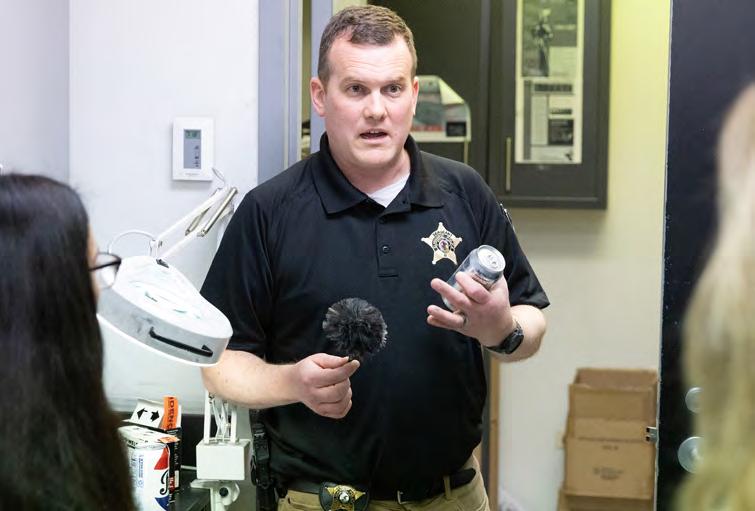
This spring’s CPA has been run by Victor Valdez, a detective within the Elmhurst Police Department. Kaczorowski explained that offering the program is mutually beneficial for the police officers involved and the residents and employees of the Elmhurst community who participate in the program.
“It’s a big growth opportunity for the class coordinators,” Kaczorowski
If you missed the chance to register for this spring’s Citizen’s Police Academy program, there’s good news. The Elmhurst Police will offer the program again this fall. Each session can accommodate up to 25 participants and is free of charge. Participants are expected to be age 21 or over, but exceptions have been made for Elmhurst University students interested in criminal justice but under age 21. ■


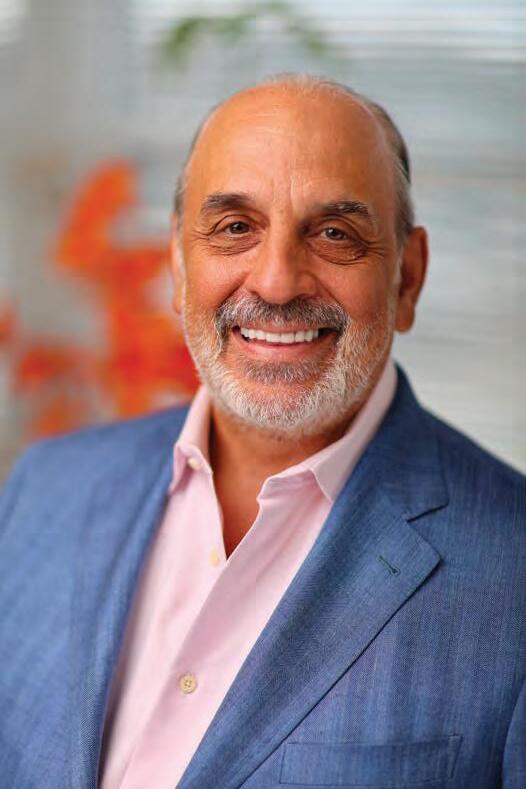
“I’m Italian. My love for others comes through food.” A truer statement was never spoken by Lisa Garber, Elmhurst resident and owner of custom decorated cookie company Belden Avenue Bakery. Garber comes from a family who understands the importance of good cooking.
“From the time I was about nine years old, I grew up working in my family’s little diner on the outskirts of Chinatown,” said Garber. “That’s where I really learned the importance of food. To cook something for someone and then give it away is to give a piece of your heart away with it.”
It’s plain to see this mantra lives on in the care she takes with her business, the former Belden Avenue Bakery. The once-cottage industry home bakeshop recently took a step out the front door. Garber’s chocolate chunk cookie is going to the commercial market!
Garber started baking her cookies about eight years ago, but the endeavor took a new turn when her day job as a law office manager went remote during COVID. As she worked from home, Garber’s son, Broadway actor Anthony Lopez (the face of Elmhurst Magazine’s January issue), encouraged his mom to turn her custom cookie hobby into a business.
Lopez was a huge help to his mom as she got her feet wet. Ironically, when Lopez first moved to New York to pursue his Broadway dreams, he managed the social media for Tate’s Bakeshop. “Anthony knew so much about cookie marketing from his experience with Tate’s. His advice was indispensable when I was learning
BY MAUREEN CALLAHAN

how to start my business,” Garber gratefully acknowledged.
Lopez also came up with the name Belden Avenue Bakery, after the street where he and Garber lived while he was growing up. He saw it as a way to tell their story.
In addition to her custom decorated sugar cookies, Garber has always been a fan of the usual suspects –oatmeal raisin, double chocolate chunk, Mexican and Italian Wedding, and shortbread cookies as well. Recently, she began to hone the






BY ANNA HUGHES
Since its founding in 1957, the Elmhurst History Museum has been focused on sharing the vibrant backstories of the city through thoughtful collection, enlightening exhibits, and diverse educational experiences. The Museum plays a vital role in the community by showcasing the richness of its past, fostering a deeper appreciation of local heritage, and nurturing a lasting sense of pride.
The newest addition to the Elmhurst History Museum family is Emma Marston, the Curator of
Education and Public Programs. In this role, Marston is tasked with carrying out the museum’s mission by creating innovative programs to connect students, families, and adults to Elmhurst’s local history.
“Everyone that I’ve talked to, both on staff and visitors, has just been really wonderful and welcoming. So I really feel lucky to be part of such a great community,” Marston said. “Especially with the kids—I spend a lot of time right now in the classrooms, and it is really a great feeling when you know the kids are excited to see you. They want to hear all about these things.”
Thanks to Marston’s work, students are able to participate in engaging programming like living history experiences at the Churchville One-Room Schoolhouse, museum field trips, and portable in-classroom lessons. Getting to interact with students of all ages in a variety of upbeat settings is one of the most exciting parts about Marston’s job.
“I do the fun parts,” Marston said. “Even the young kids, they come up with these really great questions. And sometimes…I’m like, I don’t know the answer to that, this is a thing that I need to research and

“What I think is interesting is… how much that we see in the past is not that different from what we’re doing every day in our own lives.”
- EMMA MARSTON,
ELMHURST HISTORY MUSEUM CURATOR OF EDUCATION AND PUBLIC PROGRAMS
kind of do some digging into. You never quite know what the kids are going to tell you, but it’s always very interesting.”
Marston already has some exciting summer events scheduled, including a summer concert series at the museum’s new outdoor performance space. The venue will host a variety of concerts and outdoor activities with entertainment for all ages. Marston said it will be a great communal hub for residents and visitors alike to enjoy summertime at the museum.
In July, Marston and the museum will host the Family Farm Fest, where families can travel back in time to the early days of Elmhurst by
participating in interactive farm chores, creating unique art projects, and visiting the petting zoo. The event goes hand-in-hand with their current exhibit, “Acre by Acre: Our Farming Heritage,” and it provides a hands-on perspective that allows residents to immerse themselves in the city’s agricultural roots.
“You don’t want to think about [history] in terms of just memorizing names and dates, right? That’s not interesting,” Marston said about the importance of collaborative and interactive history lessons. “What I think is interesting is... how much that we see in the past is not that different from what we’re doing every day in our own lives.”
Marston’s extensive experience in education and local history is an asset to both the museum and the community. Dave Oberg, Elmhurst History Museum’s Executive Director, said he’s thrilled to welcome her to the team.
“With her unique background, we know she will continue to grow our school and public programming, with a focus on lifelong learning, local history, and community,” Oberg said.
For more information about programming and upcoming events at the Elmhurst History Museum, visit ElmhurstHistory.org. ■

“The way I felt walking back inside that school when we registered my daughter Avery when she was two years old overwhelmed me with emotion. It was like God was wrapping his arms around me and my family to let me know this was the place to raise my daughter.”
Her sentiment reflects what makes ICGS special: students grow academically and spiritually, build lifelong friendships, and join a supportive, faith-filled community.
“As I look back as an adult, I realized the quality of the education I received, as well as learning how to act as a respectful Catholic at a very young age,” Peterson recalled.
Photos from the past include the faculty from 1956, the first grade class from 1940, and the class of 1959 graduation.
students understand and appreciate the devotion required to build ICGS into the school it is today.
In addition, students have been interacting with various alumni throughout the year. Many current students come from multigenerational ICGS families—one family is fourth-generation—which means there is a close-knit family of parents and grandparents who are eager to share their stories.


the building from dusk until dawn each day,” Father Tom Paul, ICGS Pastor, said.
Students, families, and alumni have been able to celebrate the accomplishments of ICGS during the 2024-2025 school year through a variety of activities and events to commemorate the quasquicentennial year.
The year started with an opening Mass in August, celebrating “125 Years of Growing in the Light of Christ,” with the dedication of new lighting on the exterior of the IC Church and school building.
“Just as the alumni and students of Immaculate Conception illuminate the world, this lighting will illuminate
Students have spent the year learning about the school’s history, tracing back to 1862 when St. Mary’s became the first Catholic Church in the village. (At the time, the area housed 49 families, fewer than 20 of whom were Catholic.) These lessons help
On May 1st, ICGS hosted an enrichment career day, where students had a chance to hear from ICGS alumni about how their education shaped their careers and lives.
Though the official celebrations of this milestone are coming to an end, the pride within the ICGS community—and their gratitude for those who paved the way—will endure for generations to come. The school’s continued success stands as a testament to the unwavering dedication of its staff—past and present—and the enduring commitment of local families to Catholic education.
“Catholic Schools foster a strong sense of community and belonging among students, families, and faculty,” Peterson said. “Catholic Education aims to cultivate spiritual growth, helping children develop a personal relationship with God and understanding [of] their faith.”
For more information about Immaculate Conception Grade School, visit icgradeschoolelmhurst.org. ■
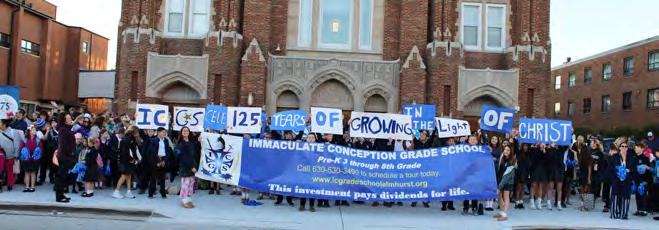

BY JEFF VORVA
Elmhurst’s boys swimming and diving team could be on the cusp of something big.
For the first time in program history, the Dukes won a sectional title on February 22 as they captured the Downers Grove North Sectional. By the slimmest of margins.
York had 231 points, and Glenbard was right behind with 230.5, and the Dukes held their first go-crazy moment for a postseason as everyone hit the pool.
First-year coach Josh Dunn, who was an assistant for three years, said he put the idea of a sectional title in the swimmers’ minds from day one.
It came through as they narrowly beat Glenbard West.
“Glenbard West absolutely crushed us in a dual meet,” Dunn said. “At that time, it didn’t give me many high hopes for sectionals. They also beat us at the conference meet, and I think the boys had enough of getting beat by Glenbard West, and they put out their best effort to get us a win. When it was over, those boys were over the moon. To be able to make history by the slimmest margin, it was surreal.”
The Dukes were sectional champs in two of the three relays.
Freshman Dymtro Rozdolskyy, senior Timothy Jensen, sophomore Matthew Glod, and senior Henry Nelson won the 200 medley relay with a 1:36.23.
Nelson, Rozdolskyy, Glod, and Jensen won the 200 free relay with a 1:26.94. Glod earned a sectional title in the 100 butterfly with a :49.83 and Jensen won the 100 breaststroke with a :57.68.
Jensen also qualified for the state meet in the 50 free with a second-place finish of :21.64.
Sophomore Connor MacLeod took second in the diving event to qualify for the state meet. MacLeod racked up a 424.05 score.
At the Illinois High School Association state meet February 28 at the FMC Natatorium in Westmont, Jensen had two heartbreaking races in the preliminaries.
Jensen just missed qualifying for the top 16 as he placed 17th in the 50 free with a :21.20. Fremd’s Tyler Franke nabbed the final spot with a :21.16. He also finished 17th in the 100 breaststroke with a :57.37. Stevenson’s Joshua Wang took the 16th spot with a :57.31.
But Glod was able to qualify for the second day, and he finished 16th in the 100 butterfly with a :50.34. He was 15th in the preliminaries with a :50.16.
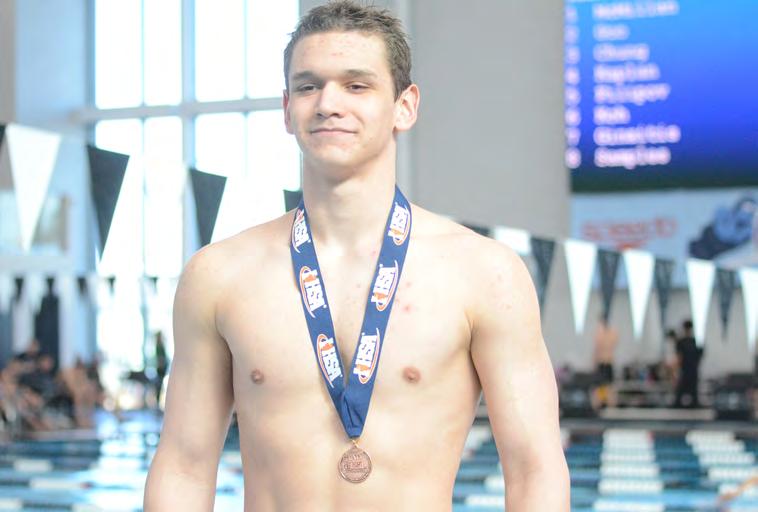

“He’s done some incredible things,” Dunn said of Glod. “He’s an athlete that definitely responds well to high expectations and coaches pushing him and encouraging him that he can be faster. It’s always really fun to see him rise to the challenge.
“For him to qualify for Saturday and to see the times he put up this season was a little bit of a surprise, but it was definitely a great surprise.”
Glod did a lot of cheering on February 28.
He had friends all over that he wanted to see do well.
As a result of success in sectional competition the week before, the Dukes had swimmers in six events at state, so Glod was pretty busy competing and cheering on his teammates.
But he is also a member of the Hinsdale Swim Club during the offseason. He was cheering on some of those teammates as well, including the 200-yard medley relay team of Luke Vatev, Josh Bey, Henry Guo, and Matthew Vatev, kicking off the state meet by setting a national record of 1 minute, 26.75 seconds.
“It takes a while to get better in swimming. But I love to see the times drop, and I love to see the improvement.”
- MATTHEW GLOD
“Yes, I was cheering for them,” Glod said. “I’m friends with those guys, and they are so good. What they did was so crazy.”
Could York ever get to that level?
That’s a long shot, but Dunn and Glod want to see more swimmers in the second round of the state meet. Glod has been swimming since he was six and loves the sport.
“I love seeing myself improve continuously,” he said. “It takes a while to get better in swimming. But I love to see the times drop, and I love to see the improvement.” ■

BY ANNA HUGHES
The Elmhurst community is mourning the loss of local legend Doug Peterson, who was known as a dedicated community member and avid supporter of the arts. Most importantly, though, he is remembered by family and friends as a kind, genuine, selfless man, as well as a wonderful husband, father, and friend.
Peterson was the founder and CEO of Chicago Records Management (CRM), a family-owned business he led alongside his wife, Cindy. His passion for theater began during his college years at Southern Illinois University, where he initially majored
in business but later switched to theater after being cast in a production of “Little Mary Sunshine.”
Peterson transferred to Columbia College in Chicago to pursue this new path and, with a few classmates, co-founded Prop Thtr, a non-equity theatre group that remains active and thriving today. In a search for enhanced financial stability, he transitioned from acting to sales, founding CRM in 1988. Beyond his business endeavors, Doug served as the executive producer of the critically acclaimed and Jeff Award-nominated play “Hizzoner,” a portrayal of Richard J. Daley. He also held leadership roles in local theater
organizations, including past presidencies at both the Elmhurst Children’s Theatre and the York Drama Boosters. He also played in a rock band and, more recently, performed with GreenMan in Elmhurst.
Peterson was a founding member of the Elmhurst Centre for Performing Arts (ECPA) - now the Encore Center for Performing Arts - a nonprofit organization dedicated to offering theater, music, dance, and comedy performances where artists and patrons can share their love of the performing arts. Peterson constantly worked to carry out the ECPA’s mission of creating vibrant art in the western suburbs, cementing
The inaugural Dan Gibbons Twilight Trot, a 5K fun run benefiting four local Elmhurst organizations, will take place on Saturday, May 31, 2025, at 6:30 p.m. This exciting event is a new addition to the long-standing tradition of the Dan Gibbons Turkey Trot, with the goal of supporting hunger relief and basic human needs throughout the year.
All proceeds from the event will directly benefit four local nonprofit organizations dedicated to fighting hunger in the Elmhurst community:
• Elmhurst Walk-In Assistance Network
• United Community Concerns Association (UCCA)
• Immaculate Conception Food Pantry
• Elmhurst/Yorkfield Food Pantry
This year’s Twilight Trot provides a unique opportunity to address hunger and basic needs halfway through the year, well before the traditional Thanksgiving efforts tied to the Turkey Trot. “It’s time to step up our efforts,” said Dan Gibbons, founder of the event. “The Twilight Trot will help our neighbors in need with a check in June, halfway to our normal December distribution of funds from our Thanksgiving Day Turkey Trot.”
The 5K route for the Twilight Trot will follow the same scenic course as the Turkey Trot, including the Illinois Prairie Path and finishing at the Fountain in Wild Meadows Trace Park. “UCCA is so excited to be part of the Dan Gibbons Twilight Trot and grateful to receive proceeds from this amazing event,” said UCCA President, Shari Haug. “With the
BY HINSDALE MAGAZINE GROUP STAFF
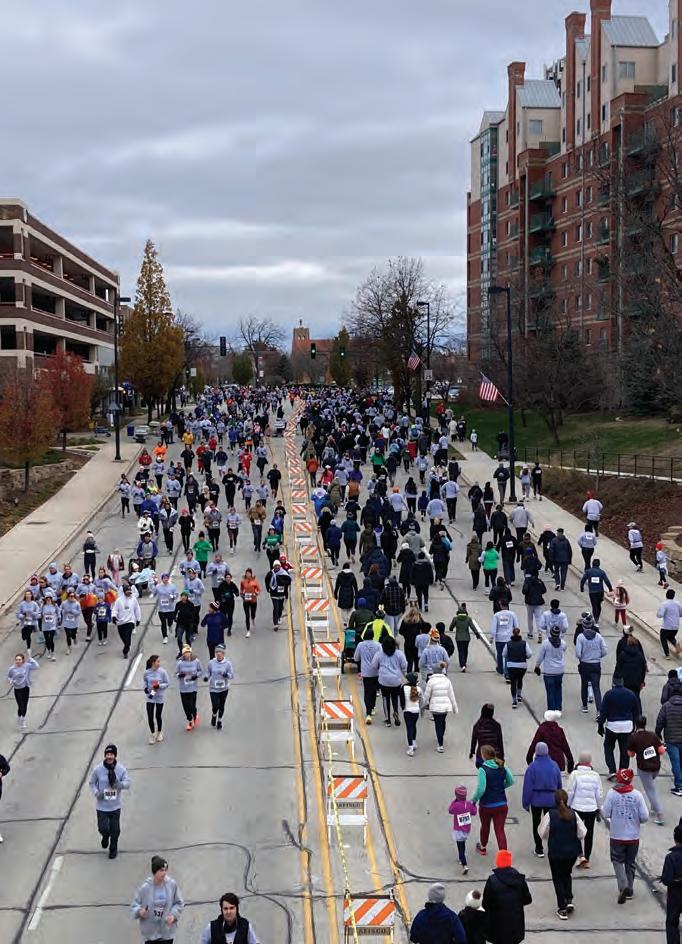
community’s support, we can continue to help provide food to local families who need it most.”
The Dan Gibbons Twilight Trot builds on over 41 years of service from the Turkey Trot, reminding the community that hunger and human
needs are issues that require attention all year round.
Registration for the Twilight Trot is now open, with a fee of $35 per participant. To register or learn more about sponsorship opportunities, visit DanGibbonsTwilightTrot.org. ■

BY HINSDALE MAGAZINE GROUP STAFF
For decades, the evolution of plastic surgery has been shaped by idealized images of beauty relentlessly presented through media. This pursuit of seemingly unattainable facial perfection; a straighter nose, defined jawline, and youthful appearance, often drives patients to travel far to achieve these results.
Many patients embark on a journey through multiple surgeons and treatments, each with varying philosophies; however, we may have reached a turning point. The era of skin-pulling, artificial implants and fillers, popularized by
reality television trends, has yielded unnatural and temporary results, often at the cost of individual identity.
Now, in 2025, a pioneering Chicagoarea surgeon is redefining facial rejuvenation. He champions the rediscovery of one’s true essence and a path to graceful aging.
Byun’s reputation as a distinguished plastic surgeon reflects a journey deeply rooted in his family’s legacy. As the eldest of four, he carries the combined influences of a scholarly Japanese mother and a driven Korean father, whose family played a crucial role in South Korea’s
construction industry. His father’s leadership and work on the nation’s highway system exemplify the family’s commitment to hard work and progress, qualities that have undoubtedly shaped Byun’s own character and professional trajectory.
Byun’s innate curiosity and ambition were evident from a young age. His fascination with the fusion of art and science manifested early. A memorable school project, where students were tasked with building a plane from popsicle sticks, paper, and glue, showcased his exceptional problem-solving and creative


abilities. His plane, which flew the farthest, secured victory and foreshadowed his future success.
His passion for creation and mechanical understanding was evident in all areas of his life. He won a statewide art-science competition and then, to the surprise of many, declared his ambition to become a surgeon.
Driven by his ambition to pursue education in the United States, Byun’s family relocated to Southern California during his formative years. His early experiences in America were deeply influenced by his parents’ rich cultural heritage and the vibrant diversity of California. He was raised with a profound respect for education and an unwavering work ethic, values instilled by his
Your skin is most valuable to you and only you. Don’t take it for granted.
- DR. MICHAEL BYUN
father’s exemplary dedication and his mother’s intellectual curiosity.
HOW THE BYUN LIFT WAS CREATED Byun’s pursuit of excellence led him to Northwestern University, renowned for its intensely competitive plastic surgery program. He distinguished himself rapidly, rising to the top of his residency and securing the university’s inaugural interfrated plastic surgery fellowship. His exceptional performance earned
him the privilege of training under the esteemed ‘Holy Trinity’ of Northwestern Plastic Surgery: Dr. B. Herold ‘Hal’ Griffith, Dr. Peter McKinney, and Dr. Victor L. Lewis.
“After my 11 years spent at Northwestern for Medical School, I was able to form very close relationships with my professors. Shortly after starting independently, I inherited three of my professor’s caseloads. I hate to say it, but I didn’t like any of their long-term results and knew in my heart and mind that the traditional techniques were flawed.”
Byun recognized from the outset that true facial rejuvenation began with addressing the underlying muscle structure. He knew there had to be a more physiologically sound and effective approach to improve facial rejuvenation. Through extensive research and meticulous study, Byun developed his own facial rejuvenation technique, The Byun Lift – an approach to fix the problem by reverse-engineering the aging process, using an endoscope to see underneath the face. The detail and focus enable the restoration and preservation of one’s natural features. This method has consistently delivered proven, long-lasting results.
He emphasizes the fundamental role of gravity, stating, “Gravity affects all bodies, including the face. Over time, facial muscles descend.” His innovative approach focuses on restoring these muscles to their original midline positions, allowing for a natural realignment of facial features. This ‘reverse facelift’ technique, as Byun calls it, aims to reverse the effects of aging and/or correct prior surgical interventions. He advocates for this method to become the ‘new standard’ in cosmetic facial surgery.

skin outward, widening the face. Your skin is uniquely yours and incredibly precious. It’s crucial not to underestimate its importance.
Byun’s philosophy is rooted in creating results that stand the test of time. His approach contrasts sharply with the quick-fix mentality that dominates the cosmetic surgery industry. Many surgeons promise immediate results but
Byun views the facial muscles as interlocking puzzle pieces. His technique focuses on precisely repositioning these muscles back into their original anatomical pockets. This restoration naturally contours the face, eliminating the need for excessive skin removal. The skin drapes smoothly by aligning the muscles along their natural convexity towards the midline, revealing beautifully restored muscle contours.
In some cases, previous procedures may have removed too much skin, which is essential for this natural draping process. Byun warns his patients of this through education. In cases where a patient has had multiple prior facelifts, it could end up that there’s not enough skin left to achieve an optimal outcome; you can’t just create new skin. Be wary of surgeons who essentially discarded valuable tissue – by cutting it away and pulling the remaining
What troubled me was the accelerated aging I observed in patients who had undergone traditional cosmetic procedures. The long-term effects of fat grafts, fillers, and skin-tightening devices were often detrimental; moreover, the crucial issue of sagging facial muscles was consistently overlooked.
– DR. MICHAEL BYUN
fail to consider the long-term effects of repeated procedures. His extensive experience spans diverse patient demographics worldwide, including individuals from every continent. Through years of meticulous monitoring and personalized adjustments, he has consistently learned and refined his techniques with each patient. This method promotes natural, graceful aging, allowing patients to retain their inherent beauty. Byun’s singular technique draws patients globally, as no other surgeon offers this level of expertise.
Byun’s work reflects his Eastern and Western influences and his early bicultural household, giving him a unique perspective on beauty, balance, and harmony. As he continues to explore creative outlets, he still believes the principles of art (balance, proportion, and harmony) are deeply connected to plastic surgery.
Having a flair for art and science,








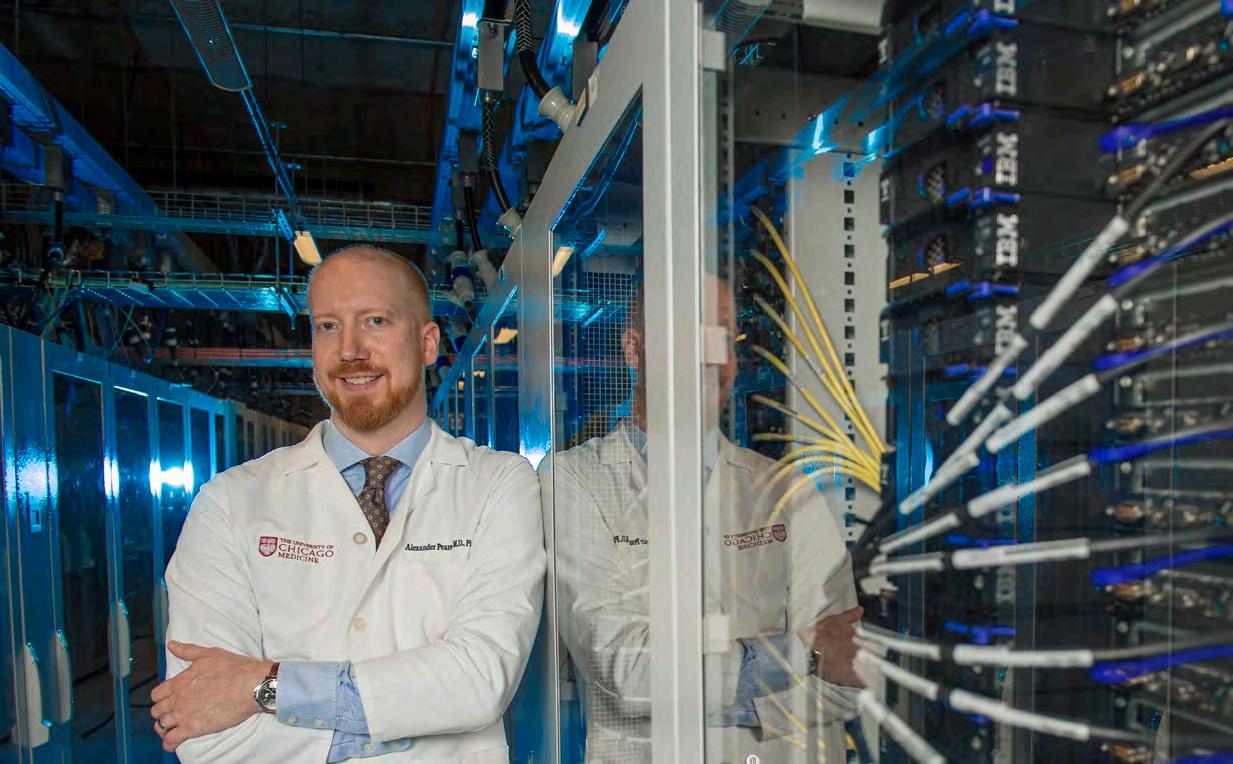
Medical training programs and practices in Illinois are on the cutting edge when it comes to considering how artificial intelligence (AI) can enhance patient care and physician functionality. For example, the University of Illinois at Urbana-Champaign’s Department of Bioengineering was the first to offer an AI in Medicine Certificate Program for healthcare professionals.
This six-week continuing education program provided physicians, medical students, and other clinicians with information about the latest in digital medicine and practical applications for it via case studies involving machine learning. Additionally, the course addressed ethical and legal considerations related to the use of AI in clinical settings.
Likewise, while University of Chicago (UChicago) medical faculty and students are not formally trained in the use of AI for clinical purposes, “there are frequent seminars, grand rounds, and journal clubs addressing AI’s role in medicine,” explained Dr. David Beiser, an emergency physician, clinical scientist and informaticist, and Associate Professor of Medicine at UChicago.
BY VALERIE HARDY
“Because the [AI in Medicine] field is still young, structured training programs are just beginning to emerge – but there’s strong interest and growing engagement at all levels,” Beiser added.
Fellow physician Dr. Alexander Pearson, who holds an MD, a PhD in statistics, and is an Associate Professor of Medicine specializing in hematology and oncology, is working to expand the machine learning and data science curriculum at UChicago’s Pritzker School of Medicine. He also runs the Center for Computational Medicine and Clinical Artificial Intelligence.
Pearson said that he is frequently asked when AI is going to arrive within the medical field, and his prognosis is that “it’s already here, and its capabilities are only increasing.”
An early use of AI in medicine is in mammography, with most mammograms in the United States having a “computer-assisted diagnostic component,” explained Pearson. He further noted how AI can help radiologists complete diagnostic tasks more cost-effectively, efficiently, and accurately.
Documentation is another area in which AI increases physician
efficiency and quality of patient care. Both Beiser and Pearson now use ambient notetaking tools, which use AI to automatically transcribe and summarize conversations between healthcare providers and their patients, allowing them to look their patients in the eye rather than at the notes on their computer screen.
According to Beiser, AI is best used in the medical field when it “offload[s] the mundane and repetitive aspects of clinical work, allowing physicians to focus more on higher-level decision making, big-picture thinking, and building stronger connections with our patients.”
Ironically, AI may offer more empathetic responses to patients than human doctors can. This is because in busy clinical settings, doctors may tend toward “accurate but rushed” communication with patients, unintentionally forgetting to respond with compassionate language, Pearson said, while “large language models never have to get home to their kids,” so they can allocate unlimited time toward acknowledging patients’ symptoms and emotions.
Medical trainees also have access to “large language models, with huge amounts of data at the elbow to

instantaneously answer medicalbased questions,” Pearson said, which he considers “invaluable.”
Even veteran practitioners lean on AI platforms “to provide decision

“It’s already here, and its capabilities are only increasing.”
- ALEXANDER PEARSON, MD, PHD, ON AI IN
support and stay current with emerging research,” Beiser noted.
These uses of AI in medicine, along with others such as grant and manuscript writing, have been correlated with decreased physician burnout, which leads to increased quality of care for patients.
However, there are still bugs in the system, and end users must be mindful of these. One concern is that medical professionals and trainees may become overly reliant on AI tools, Beiser said.
AI may also inadvertently “reinforce biases from data from

society,” Pearson said. Beiser echoed this potential for bias, explaining that “AI tools trained on non-representative data or deployed without oversight can amplify existing disparities in healthcare.”
To mitigate such bias, both Pearson and Beiser advocate that AI be used to augment, not replace, traditional medical practices. Beiser said, “The key is to…remain vigilant in how we implement and supervise its use in both clinical practice and training environments.”
While the incorporation of AI into medical treatment and training brings a mix of advantages and challenges, one thing is certain: “medicine in the future will look different than it looks now,” Pearson said, predicting that “the most successful physicians will be the ones who integrate technology into their realm of practice.” ■


Trinity High School sets the standard for excellence in education with 100% college acceptance and $182 million in scholarships awarded over six years (an average of $400,000 per student).
With our all-girls Catholic education and the prestigious International Baccalaureate curriculum, Trinity empowers young women with the confidence and skills to excel in college—and beyond.
Find out more information on 7th & 8th Grade Shadow Opportunities, 8th Grade Entrance Exam, and private tours.
Transportation available.

7574 Division River Forest, IL www.trinityhs.org 708.771.8383



Using
the Advanced Photon Source, researchers are creating smart proteins to better monitor diseases like cancer and thyroid disorders
BY CONTRIBUTING PARTNER ARGONNE NATIONAL LABORATORY
Ateam led by Nobel Prize winner David Baker used artificial intelligence and the Advanced Photon Source to design proteins that sense key molecules in the body. This work could lead to easier and more accurate health monitoring, from cancer treatment to liver and thyroid testing.
Some of the most important molecules in our bodies—like those used in cancer treatments or

that signal thyroid issues—are tiny and hard to track. Scientists need tools to detect these “small molecules” quickly and reliably. That’s where a breakthrough from the University of Washington comes in.
Working with the U.S. Department of Energy’s (DOE) Argonne National Laboratory, a team led by Nobel Prize-winning scientist David Baker created proteins that can detect these small molecules in new ways. This work was
made possible by the powerful X-rays at the Advanced Photon Source (APS), a DOE Office of Science user facility at Argonne.
To develop these new protein sensors, the team used artificial intelligence. Their goal was to build proteins that could find and attach to small molecules—like methotrexate, a common cancer drug, or thyroxine, a hormone related to thyroid health. Once a protein finds one of these molecules, it sends out a signal, similar to how a COVID test changes color to show a positive result.
The APS was crucial in this process. After designing the proteins using computer models, the team used APS’s ultrabright X-rays to examine the actual shape of the proteins at the atomic level. This helped confirm that the designs worked in real life—not just in simulations.
“These X-rays help us see the exact structure of the proteins,” said Kay Perry, a scientist with the Northeastern Collaborative Access Team at the APS.
“It’s one of the best ways to make sure any computer predictions are accurate.”
“Smart” sensors are proteins that light up or block electrical signals whenever they detect certain molecules. These signals can then be measured easily, like flipping a switch when the right molecule is present. Previously, scientists needed to iteratively test through many trials when developing such a “smart” sensor. Baker’s work provides a pathway to faster and more accurate “smart” sensor design.
These sensors could one day be used at home to monitor health conditions like liver disease, cancer, or thyroid problems. Today’s tests often can’t tell the difference between similar molecules, but these new protein-based sensors are much more specific.
Beyond medicine, the team is also looking at ways to use the technology to detect pollutants like microplastics or harmful chemicals in the environment.
This work was supported by the DOE Office of Science. ■








Kevin Kern, DO is a board certified physician with over 25 years of experience in emergency medicine and treatment of varicose veins. He combines his procedural training with specialized knowledge of vein disease to offer patients best-in class treatment that result in healthier legs. When you make the decision to schedule an appointment with Dr. Kern, you will have confidence that you’ll be talking to a friendly and happy board certified vein specialist, with the talent and expertise to provide the individualized care you deserve.


Dr. Kern has extensive training in phlebology, the diagnosis and treatment of varicose vein disease and related disorders. At Vein Specialists of Geneva, he specializes in ultrasound-guided foam sclerotherapy and endovenous thermal ablation.
Dr. Kern received his medical degree from the Chicago College of Osteopathic Medicine and served his residency at Cook County Hospital in Chicago, IL.


PRIOR EXPERIENCE:

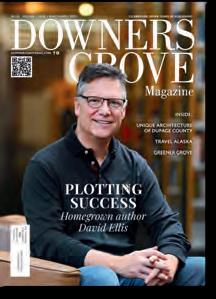
Dr. Kern has held the position of Emergency Medicine Attending Physician at some of the largest hospitals in the Chicago area including Cook County Hospital, Elmhurst Memorial Hospital, Gottlieb Memorial Hospital, and Our Lady of Resurrection Medical Center.

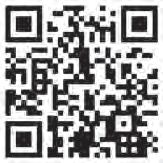






Welcome to NOTEWORTHY where we spotlight leaders in healthcare across various disciplines. In this issue, we celebrate the trailblazers who are not only advancing medical knowledge but also transforming patient care. With a commitment to innovation, compassion, and excellence, these distinguished professionals represent the heart of a dynamic industry dedicated to healing, discovery, and progress. Join Hinsdale Magazine Group as we explore their inspiring stories, exceptional achievements, and the latest advancements in the ever-evolving world of healthcare.
Elmhurst Magazine (HM): Who were your mentors and how did they influence your current practice?
Dr. Rachel Bognet: I’ve been very fortunate to have worked with many wonderful physicians along the way. From a very young age, I was enamored by my pediatrician, who could make even the sickest child laugh with his comedic routines. Although, it was a summer job in college and volunteer work at the AAD summer camp for children with severe skin conditions that started my love for dermatology. My mentor in residency was most influential in how I practice. He had an unwavering dedication to teaching the basics and a deep understanding of clinicopathologic correlation. This proved vital in how I approach every patient, with a commitment to fixing even the most challenging cases. A dedication to lifelong learning is crucial to being a trusted and compassionate physician.
EM: How do you stay passionate about medicine, especially after years of practice?
Dr. Bognet: Luckily, this is not difficult as Dr. Steil and I are constantly eager to learn about new technologies and emerging treatments. The plethora of safe and effective medicines we can now offer patients with severe eczema, psoriasis, hair loss, and acne is astounding. When I graduated residency, many of these were not created or an option yet and it has transformed how we can care for patients. Improving patient’s lives and restoring their confidence through groundbreaking medicines and cosmetic treatments is extremely rewarding.
EM: What makes your practice successful?
Dr. Bognet: Building strong relationships with our patients is at the core of our success. Open and honest dialogue about their medical or cosmetic concerns allows patients to feel at ease. Listening and offering options without judgement or coercion is the foundation of trust in any relationship.
EM: How do you see the role of precision medicine impacting dermatology in the coming years?
Dr. Bognet: Personalized medicine is already here and changes are rapidly coming due to advances in technology. We now have genomic testing available on skin cancer tissue to better guide the need for immunotherapy and radiation. Genetic testing is also allowing physicians to know which type of medication will be most effective for patients without the antiquted “trial and error” method. Better outcomes with minimal side effects is always the goal.

EM: If you weren’t a doctor, what would you have wanted to be?
Dr. Bognet: That’s a tough question because I truly love what I do! I suppose when I’m too old to do surgery anymore, I would venture into home remodeling more. I’ve always loved old homes and restoring beauty and balance has always been a passion.
CSC Steil Dermatology
125 W 2nd St, Hinsdale, Illinois and 5157 Main St, 205, Downers Grove, Illinois
630-455-0045
cscdermatology.com
Elmhurst Magazine (EM): How did you decide on your area of specialization?
Dr. Malhotra: I was initially drawn to dermatology because of my own experiences with severe acne and precancerous moles—challenges that allowed me to deeply relate to my patients’ concerns. What ultimately solidified my passion for the field was its unique blend of medical, surgical, and cosmetic care. The skin is a powerful reflection of overall health, and I find great fulfillment in helping patients not only achieve healthier skin but also regain their confidence.
EM: How do you approach conversations with your patients?
Dr. Malhotra: I approach every patient conversation with empathy, openness, and a genuine desire to understand their concerns. Whether it’s a medical issue or a cosmetic goal, I believe in creating a safe space where patients feel heard and respected. I take the time to listen carefully, explain diagnoses and treatment options clearly, and involve patients in the decision-making process. My goal is to build trust and ensure that every patient leaves feeling informed, supported, and empowered in their care.
EM: How has technology changed the way you practice medicine?
Dr. Malhotra: Technology has transformed dermatology in incredible ways—from how we diagnose and treat skin conditions to how we connect with patients. Tools like digital dermoscopy, AI-assisted skin analysis, and advanced laser technologies have elevated both the precision and outcomes of care. On the cosmetic side, we now have more refined, non-invasive options than ever before, which means better results with less downtime. Treatments such as Sofwave, Fraxel, Diamond Glow medical facials are just a few of the amazing things we offer.
EM: How do you stay current with the latest medical research and treatments?
Dr. Malhotra: Staying up to date is essential in a constantly evolving field like dermatology. I regularly attend national conferences, participate in continuing medical education (CME) courses, and stay engaged with leading dermatology journals. I’m also part of professional networks and societies that provide access to the latest clinical guidelines, research, and treatment innovations. Whether it’s a breakthrough in biologics for skin disease or a new cosmetic technique/treatment, I’m always looking to integrate the most effective, evidence-based approaches into my practice to provide the highest standard of care for my patients.

EM: What’s the one thing you wish patients understood about the medical process?
Dr. Malhotra: I wish more patients understood that healing—whether medical or cosmetic—is often a process, not an instant fix. We live in a world of quick results, but dermatology, in particular, can require patience and consistency. Whether we’re treating acne, managing a chronic skin condition, or working toward aesthetic goals, meaningful results take time and collaboration. I always encourage open communication and realistic expectations, because when patients feel informed and involved, the journey becomes much more rewarding—for both of us.
EM: How do you maintain a healthy work-life balance?
Dr. Malhotra: It’s definitely a juggling act, but I’ve learned to prioritize the things that recharge me. Running around outside with my two little boys, cheering them on at their games, playing tennis with my husband, or squeezing in a workout (and a good laugh) with my girlfriends—those moments keep me centered. Balance isn’t always perfect, but staying active, connected, and occasionally escaping with a good book or trip helps me show up as my best self, both in the clinic and at home.
SKN Institute
105 S York St # 500, Elmhurst, Illinois 630-349-3040 sknin.com

Elmhurst Magazine (EM): What inspired you to pursue dermatology and establish CSC Dermatology?
Dr. Christina Steil: During my medical internship, I was caring for a complicated patient with unusual skin lesions. The dermatology team was called in and witnessing the attending dermatologist diagnose the patient at the bedside was a pivotal moment that inspired me to pursue a career in dermatology. I was fascinated by how the skin provides insight into the health of our body. My other passion was technology and its potential to enhance patient care. I established my own practice to have the flexibility to implement the latest technologies in patient care.
EM: Could you elaborate on your areas of specialization within dermatology?
Dr. Steil: I specialize in both medical and cosmetic dermatology. I began my practice in 2002 with a focus on medical dermatology, aiming to help people achieve better health. Early in my career, I noticed a significant number of patients with sun-damaged skin. These were individuals who enjoyed outdoor activities but at the cost of their skin’s health and appearance. As a result, my practice in medical dermatology naturally expanded to include helping patients restore the health and appearance of their sun-damaged skin. Within a few years of starting CSC Dermatology in 2002, I began adopting new technologies and offering procedures to achieve this goal. CSC Dermatology became known for being the first in the area to offer many treatments. I was one of the first to train on using the injectable Sculptra™, and I was fortunate to be trained by the physician who developed the technology.
We were also the first in the area to offer medical Photodynamic Therapy (PDT) for treating pre-skin cancers, known as actinic keratosis. I was grateful to treat an elderly man with severe sun damage using PDT, which helped reduce and slow the progression of his skin cancers. Additionally, we were one of the first to offer lasers to treat acne as an alternative to traditional medications such as oral antibiotics and isotretinoin..
For me, the practice of cosmetic dermatology and the use of lasers to treat sun-damaged skin is a continuation of the medical treatment of sun-damaged skin, pre-skin

cancers, and skin cancer. I ensure that all patients who receive a skin examination and have photodamaged skin are educated on their options to restore their skin’s health and function. I inform them that we have lasers that can delay the aging of their skin and make them aware of published studies showing that certain lasers we use to improve the skin’s appearance can also reduce the risk of non-melanoma skin cancers.
EM: What innovative treatments or technologies have you recently incorporated into your practice?
Dr. Steil: We are so excited about our newest device: the BBL® HEROic™ by Sciton. We have been offering BBL Fotofacials for years to prevent photoaging. The HEROic™ technology brings AI to the treatment room, making our treatments more comfortable, effective, efficient, and safer for our patients.
CSC Steil Dermatology
125 W 2nd St, Hinsdale, Illinois and 5157 Main St, 205, Downers Grove, Illinois
630-455-0045
cscdermatology.com






BY LAURA MICHAUD & MELISSA

WILSON
According to the National Institute of Mental Health (NIMH), approximately 1 in 5 adults live with a mental illness each year. The most common mental health conditions include anxiety disorders (31.6%), major depression (15.3%), substance use disorders (18.1%), and bipolar disorder (2.5%), which can significantly impact daily life, relationships, work, stress management, and basic activities. In severe cases, mental health issues can lead to substance use and suicide.
Sadly, only 50% of adults with mental illness receive any treatment.
Deb Soszko, Board Certified Music Therapist and Director for Dynamic Lynks Music Therapy, stated, “The hardest part of therapy is recognizing the need for support. Once acknowledged, it gets easier. Just stating the scary part out loud makes the next step seem like going downhill.”
Performing arts plays a significant role in supporting mental health, with many powerful tools available that most are unaware of. These tools foster creativity, reduce
anxiety, build self-esteem, and offer a sense of belonging.
Music Therapy helps patients reach emotional balance through expression with lyrics. Songs tell stories, allowing people to hear they’re not alone, and solutions can be found for emotional wellness. Freedom Sings USA (501(c)3) is a great example of an organization that uses music therapy for veterans and their families to create outlets for their stories through the process of songwriting.
Dance Therapy releases endorphins, encourages emotional expression, and offers a healthy outlet for pent-up feelings. Dance is proven to improve cognitive function and reduce dementia risk. Geni Lucchesi, DuPage Dance Academy’s Director, reflected, “Because dance involves mental effort, social interaction, and movement, a multitude of studies indicate this stimulation significantly reduces the risk of dementia.”
Soszko discusses a session at an eating disorders clinic where women were hunched over and quiet at the start. She asked them to dance with their eyes closed, picturing themselves as the person they wanted to be. After this 3-minute exercise, the women stood
taller, and self-expression flowed freely. “Once completed, their words just started flowing. They were saying, “I really think I can do this. Why can’t I? Who says I can’t?”
Theater Arts Therapy combines arts and therapy. For those struggling to express themselves or process experiences, art becomes a vessel to connect with emotions and express pent-up feelings. According to Azizi Marshall of the Center for Creative Arts Therapy, “We use acting and improv as therapeutic tools. Whether through non-verbal communication or role-playing, it allows people to articulate and understand feelings they may otherwise have difficulty expressing.” ■


About the authors: Laura Michaud is a founding member of the Encore Center for Performing Arts and founder of Chicago theaters and the Belmont theater district. Melissa G. Wilson is a performing arts enthusiast, author, and renowned networker. For more information visit ECPA-Elmhurst.org and Networlding.com.
Hinsdalean Luke Adams can attest to that.
Adams (20) is a third baseman for the Biloxi Shuckers, the AA affiliate of the Milwaukee Brewers. Although he’s had almost a decade of baseball experience since his first trip to Cooperstown—including being drafted in 2022 and hitting home runs out of professional ballparks—his time in the bunks stand out among some of his favorite memories.
“Cooperstown was one of, if not the most, special tournaments I’ve ever played in. The atmosphere was phenomenal,” Adams said.
He remembers it as the first time he competed against talented players from across the country—namely places like Florida and California, whose young players benefit from longer baseball seasons thanks to milder weather.
“From the opening day competing against 100+ teams in skill challenges, to playing the Florida Stealth, a powerhouse, at 2 AM because of rain delays that day, to rooming with 12 players and three coaches in a sauna of a room, I had a blast,” Adams said.
Adams had a chance to play in Cooperstown two summers in a row, accompanied by his favorite travel companion and number one fan: his dad, Dan Adams. Dan was one of Luke’s coaches during his second year, which meant enhanced father-son bonding and very busy days.
“The memories of playing so many games in a short period of time, and just the kids bonding and all the fun of being in the bunk house together, it’s got to be one of the top experiences [from Luke’s career],” Dan said.
Dan has been in the bleachers cheering or in the dugout coaching for countless games. To him, Cooperstown stands out as an exceptional playing experience. Between the fabulously-maintained
diamonds and the meticulous attention to detail from umpires and officiating crew, he said the opportunity to play on mini-Major League fields is an unmatched experience for any young player.
“I think that anybody who plays baseball and is serious about baseball at a 12-year-old age should try to go with their team,” Dan said. “It’s one of those once-in-a-lifetime experiences that you get to have as either fatherson or even as a family. I don’t think any kid that plays baseball should miss out on that.”
Although Luke’s killer swing and eye for the game have earned him professional success, it’s moments like Cooperstown that foster the love for the sport. His teammates (three of whom are currently Division I athletes) still keep in touch, telling jokes and marveling at how far they’ve come since their youth baseball days.
“There are still stories to this day we’ll talk about from Cooperstown,” Luke said. ■
“Cooperstown was one of, if not the most, special tournaments I’ve ever played in.”
- LUKE ADAMS

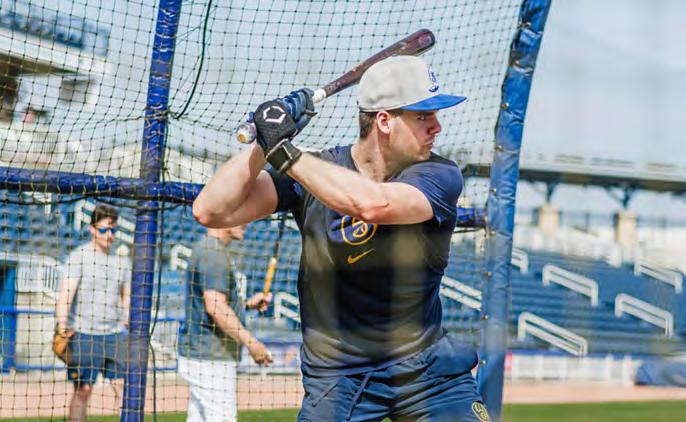

afternoon, which was great because we played a 4:00 p.m. game, but it was on tape delay, so nobody in the U.S. watched it in real time. The only people who knew we won were either Canadians, residents of Lake Placid, broadcasters who aired the game or people who had listened to it live on the radio. I don’t know how many people had planned to watch it either because we had lost 10-1 to the Soviets at Madison Square Garden just ten days before we faced them in the Olympics. Most people don’t want to watch a car crash in real time (O’Callahan laughed). But after we won that afternoon, the networks were saying things like, ‘We’re not going to tell you what happened in Lake Placid this afternoon, but be sure you don’t miss it tonight at 8!’
DO YOU REMEMBER THAT MOMENT WELL?
Yes! I’ll never forget it. The stadium was absolutely crazy! People on the street outside were going nuts! The team was all staying in the Olympic Village, but after we played, the hotel where our parents were staying threw us a big party. They put together a few conference rooms, and we had dinner while we watched the game with our families. It was such an amazing night!
BEFORE THE GAME AGAINST THE SOVIETS, COACH BROOKS TOLD THE TEAM, ‘THIS IS WAY MORE THAN A HOCKEY GAME.’ WHAT DO YOU THINK HE REALLY MEANT?
There really was so much more to it than hockey. The country had been through a lot of turmoil in the decades before that game. Most of the guys on that team were born in the 50s. Many of our fathers had fought in the Korean War and were very proud Americans. A generation gap developed in the 60s - an era of racial and social unrest, Vietnam,
Kennedy getting shot, draft dodging, etc. The country was very disconnected. Then we showed up in Lake Placid in 1980, and for two weeks, we played every other night. The momentum built up, and for the first time in a long time, everyone was very proud of the USA again. When we beat the Russians, it really brought the country – and the generations- back together.
WAS THE FINLAND GAME – THE FINAL HOCKEY GAME OF THE 1980 OLYMPICS IN WHICH TEAM USA CAPTURED THE GOLD – AS HARD?
Put it this way, the practice we played after we won the game against the Soviets but before we played Finland was the hardest one we ever had. Coach Brooks never dialed it down. As a matter of fact, it was the opposite. He pushed us so hard that we were like, ‘What is he trying to do? Kill us?’ That’s when he told us, ‘Do you think the Fins are going to lie down and give you this game? You’ve played six games as the underdog. Now you’re the favorite. The world is watching you, and everybody is waiting for you to lose. And if you do, you will take it to your grave!’
He was right. The Fins were a phenomenal team. The last period of that game, to our credit and Coach Brooks’, was probably the best 20 minutes of play in our year together as a team. We were down 2-1 going into the third period, but the Fins barely touched the puck in that last period. We beat Finland 4-2 for the gold!
HOW DO YOU THINK BROOKS’ STYLE OF COACHING AFFECTED THE OLYMPIC VICTORY?
Brooks knew his players well. He had coached most of them at some time before he assembled his Olympic team. He reminded all of us daily that he expected top effort every day. ‘Show up one day and give me 95% and you’ll make my job easy because I’ll get rid of you,’ he always told us. He constantly pushed us and that made us push each other.
I loved playing hockey in high school, and my team at Boston University (BU) won the NCAA tournament. That led to my spot on the Olympic team. While it was the honor of a lifetime, I always knew there would be life after hockey. Even when I was at BU and got drafted by The Blackhawks, the first thing I thought was, ‘If I play in Chicago, maybe I could learn how to trade commodities.’ So, playing hockey got me to where I eventually wanted to be. I now own an asset management firm.
We didn’t really do anything this year to celebrate, but we get together from time to time, and we’re all still close. Our first big reunion was in 2000. I talk to [Mike] Eruzione the most because we’re both from Boston and went to BU together, and now we both live in Florida. I talk to [Rob] McClanahan probably second most. But we’re hockey guys, so we’re all tight. Even Ralph [Cox] and Jack [Hughes], the last two guys who were cut from the roster right before The Olympics, are always included when we meet. We’ll probably do something for the 50th anniversary. ■

Over hill, over dale, as we hit the dusty trail, and those Caissons go rolling along…
BY MAUREEN CALLAHAN
The United States Army, America’s oldest and largest branch of armed forces, will celebrate its 250th birthday this summer. On June 14, 1775, more than a year before the Declaration of Independence was signed, the Second Continental Congress approved the formation of a militia. It was a time of uncertainty for an unstable, would-be nation that was still finding its footing in a struggle for independence from British rule.
Before formal organization, the thirteen colonies relied on local militias. These groups were part-time soldiers who came together to defend their individual colonies in times of unrest through raids and ambushes. Most relied on their own firearms and possessions and had no formal
military training. As time went on, these ordinary citizens in the local colonial brigades secretly trained to fight the British.
The actual organization of these previously provincial, unstructured - albeit well-intentioned - groups of soldiers became the Continental Army. The brigade was the initial unified force to represent all 13 colonies in the fight for independence during what later became known as the Revolutionary War.
General George Washington, who had garnered military experience and gained notoriety in the colonies during the French and Indian War (1754-58), served as the first Commander-in-Chief of the Continental Army. The Army managed to secure independence through a combination
of strategic battles, guerilla tactics, and the assistance of French allies. Ultimately, the British surrendered at the Battle of Yorktown on October 19, 1781, which ended the war.
In the late 1700s, American patriots recognized the strategic location of the west bank of the Hudson River. Understanding the significance of its position, Washington commissioned designs for the fortifications built at this location that eventually evolved into the United States Military Academy at West Point. The Academy was founded after the Military Establishment Act of Thomas Jefferson’s presidency. It opened on March 16, 1802.
Today, the Corps of Cadets (student body) numbers around 4,400, with 1300 active-duty soldiers also in
residence. Admission to West Point’s engineering and liberal arts degree programs is very selective, with entrance gained through an appointment made by a U.S. senator or representative.
There are other ways to earn a commission in the U.S. Army - the Army Reserves Officer Training Corps (ROTC)- which offers competitive educational scholarships, the Officer Cadet School, or direct appointments in select legal, medical, ministerial, and technical fields. All applicants are required to be high school graduates, pass a medical and physical exam, and be at least 17 years of age.
Today, the U.S. Army operates with an active component and two reserve modules – the United States Army Reserve and the Army National Guard. Roughly 500,000 soldiers serve actively in the U.S. Army today, with another 550,000 serving in the reserves. The military branch has over 100 installations worldwide, including major bases and smaller outposts.
You only turn 250 once! That said, there will be celebrations all over the country this summer for the Army’s semiquincentennial anniversary. A tribute to the U.S. Army, which highlighted its various eras, rolled through the Rose bowl

Parade in Pasadena this past January in the form of a float entitled: This We’ll Defend: 250 Years of Service.
The U.S. Army Heritage Center Foundation in Carlise, PA, an honored Smithsonian affiliate research library and museum, is planning a birthday dinner on June 14, 2025. Guest speakers and the 28th Infantry Band will entertain ticketholders.
The National Museum of the United States Army in Belvoir, VA, is
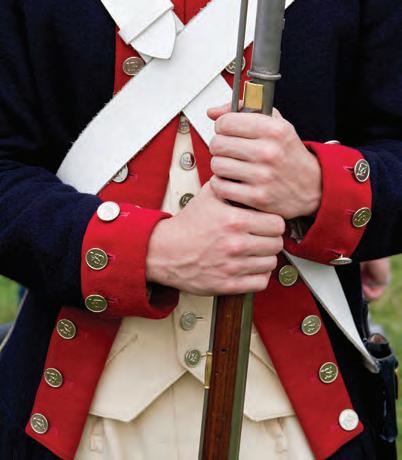
showcasing a special exhibit entitled Call to Arms: The Soldier and the Revolutionary War, which will include a rare collection of Revolutionary War artifacts from the original colonies, as well as England, France, and Canada, along with soldiers’ personal stories from America’s first veterans. The exhibit begins in May and is set to run through the birthday of America in 2026. Virtual attendance is possible.
….For where’er you go, you will always know that those Caissons go rolling along. (From the official song of the United States Army, The Army Goes Rolling Along).
Join Cantigny Park in Wheaton for a day of family fun on Saturday, June 21, from 10:00 a.m. to 4:00 p.m. as they celebrate the 250th Anniversary of the United States Army.
Meet active-duty soldiers, play in an inflatable booth camp, make camouflage crafts, and step back in time to see soldiers’ gear throughout history.
Tours of the First Division Museum, gardens and grounds and Colonel McCormick’s weapon collection are ongoing throughout the year.

BY VALERIE HARDY
Three local high school seniors shot for the green and made it. In this case, “the green” is not on the golf course but rather refers to money, which Downers Grove’s Colin Finn and Elmhurst’s Chloe Cummins and Matthew Hamblin have much more of for college, having recently received the Western Golf Association’s (WGA) Chick Evans Scholarship.
WHAT IS THE EVANS SCHOLARSHIP, AND WHO IS ELIGIBLE TO RECEIVE IT?

The Evans Scholarship provides full tuition and housing funding for students attending a qualifying
four-year university. High school seniors and college freshmen may apply for the Scholarship after successfully completing a minimum of two years as a golf caddie and receiving a nomination from their sponsoring golf club.
In addition to having a strong caddie record, students must have a B-average through their junior year in high school, clearly demonstrate financial need, and consistently display outstanding character, integrity, and leadership to be eligible for the Scholarship.
Evans Scholars live together in a dedicated Evans Scholarship House or on a designated resi-
dence hall floor, so Scholarship applicants are expected to apply to one or more of the 24 Evans Scholarship universities, including the one(s) in their home state if applicable. Once accepted to their colleges, students awarded the Scholarship are matched with a partner college.
Most Evans Scholarship schools are in the Midwest, with the University of Illinois Urbana-Champaign boasting the greatest number of current and alumni Scholars. However, the Program has expanded to colleges across the nation, and a record 1,190 caddies are currently enrolled in college as Evans Scholars, with



an estimated 360 more awarded the Evans Scholarship this year.
The Scholarship was founded by Charles “Chick” Evans Jr., who was introduced to golf while caddying at Chicago’s Edgewater Golf Club in the late 1890s. Evans went on to become one of the nation’s top amateur golfers and was urged to turn professional, but he was not interested in golfing for money. To retain his amateur status, Evans put his golf earnings into an escrow fund, which he decided to use to finance educations for hardworking caddies whose families could not afford college.
In 1928, Evans asked the WGA to oversee the fund, and the first round of Evans Scholarships were awarded in 1930, sending two caddies to Northwestern University. Until World War II, all Evans Scholars attended Northwestern, the site of the first Evans Scholarship House. When Evans’ original investment was exhausted, WGA Directors made contributions of their own to continue the Scholarship Program.
The WGA still runs the Evans Scholarship Foundation, which
issued approximately $37 million in Scholarships this year. Evans Scholarships are funded by contributions from over 38,000 Par Club members across the country, proceeds from WGA championship golf tournaments, and donations from some of the more than 12,285 Evans Scholar alumni.
Cummins, Finn, and Hamblin all said receiving the Evans Scholarship has been “life-changing” and working as a caddie has been invaluable.
“Caddying made me so much more confident.”
– MATTHEW HAMBLIN, 2025 NEW EVANS SCHOLAR
Cummins started caddying at River Forest Country Club at age 13 and is one of 11 caddies in her extended family. She said, “I swore up and down that I would never be a caddie – I’m not an outdoorsy person and I don’t like the heat – but I saw my cousins get up and work, making good money and some even got the Evans Scholarship, and I thought it sounded like a good gig!”
Hamblin began caddying at River Forest Country Club as a “shy
freshman” along with friends who decided to try it out as a summer job. “Caddying made me so much more confident, opened many new doors, and helped me…make so many great connections,” he explained.
Finn has caddied at Hinsdale Golf Club for three years and keeps coming back thanks to the “inclusive and supportive members” and the connections he has made with them. Finn also appreciates how flexible caddying is. He runs cross country and track for his school and said, “The Club made it very easy for me to work while having practice every day.”
Finn will attend the University of Illinois to study sports management, Hamblin the University of Iowa to major in finance and accounting, and Cummins Marquette University to major in biomedical sciences.
No prior knowledge of golf is necessary to become a caddie. An orientation program trains new hires on caddying expectations, rules and regulations, and more.
Young men and women interested in caddying may check the club locator on the WGA website (wgaesf.org) to find a participating club.■
BY HINSDALE MAGAZINE GROUP STAFF

Oak Brook will come alive this summer with one of Chicagoland’s most anticipated events—the Taste of Oak Brook. On Thursday, July 3rd, 2025, thousands of people will gather to enjoy an unforgettable evening of food, music, and entertainment. With gates opening at 4:00 p.m., the festivities are sure to captivate visitors from all stages of life.
The Taste of Oak Brook is renowned for offering a unique blend of culinary delights. Last year’s event showcased 16 local restaurants, including favorites like Fogo de Chao, Violi, and Coa, and 2025 is set to raise the bar. Guests will have the chance to sample a diverse mix of flavors and explore Oak Brook’s vibrant dining scene, which includes the beer garden sponsored by Alter Brewing.
A highlight of the event is always the entertainment, and this year is no exception. Music fans will be in for a real treat with two amazing performances. Fearless, the ultimate Taylor Swift tribute band, will take the stage, as will Sixteen Candles, an 80s tribute band.
As the sun sets, the real magic begins. At dusk, the skies over Oak Brook will light up with Chicagoland’s best fireworks show. This year, the event will also feature an expanded drone show.
The Taste of Oak Brook is free to attend, making it accessible and fun for the whole family. Parking for the event will be available in advance, ranging from value parking at $20 to VIP parking at $50.
Visit Oak-Brook.org/Taste for more information.

BY CONTRIBUTING PARTNER MAINSTREET REALTORS
As the ground thaws and Chicagoland’s yards begin to awaken, homeowners have a golden opportunity to transform their properties and capture the attention of potential buyers. Curb appeal isn’t just a buzzword—it’s a critical factor that can significantly impact your home’s marketability and final sale price, especially during the busy spring real estate season. Whether you’re looking to sell or just keep your house looking its best this season, here are some tips that can help.
The journey to an eye-catching exterior begins with a thorough assessment. Walk to the street and view your property with fresh eyes. Chicagoland’s communities are known for their distinctive charm. Ensure your home reflects the character and care typical of the community it’s stationed in.
Landscaping is your most powerful tool. After the harsh winter, your yard likely needs some TLC. Start by cleaning up—remove fallen branches, dead leaves, and any winter debris. Then, create a crisp and clean edge around your yard’s perimeter, and consider a fresh layer of mulch in garden beds.
Don’t underestimate the power of pressure washing. Our region’s winters can leave siding, driveways, and walkways looking dingy. A thorough cleaning can make your home look years younger, removing salt stains, mud, and winter grime. Pay special attention to windows—clean, sparkling glass reflects well-maintained pride of ownership.
Color can dramatically transform your home’s exterior. A fresh coat of paint on your front door can work wonders—consider bold yet sophisticated colors like deep navy, forest green, or even pure black to send the message that your home is updated and on-trend. Matching this with updated hardware creates a cohesive and inviting entrance.
Symmetry and strategic landscaping can elevate your home’s visual appeal. While you likely don’t want to invest a ton in landscaping just before you move, there are small things you can do to make a big difference. Potted plants flanking your entrance, well-trimmed shrubs, and a manicured lawn create a sense of order and intentionality. Native plants like purple coneflowers, black-eyed susans, and ornamental grasses thrive in our climate and create maximal impact with minimal cost.
Remember, curb appeal is about creating an emotional connection that helps potential buyers envision themselves in your house. Happy selling! ■
The 55th Annual Elmhurst University President’s Community Breakfast took place on March 8. Featuring keynote speaker Dr. Troy VanAken, Elmhurst University President, the President’s Community Breakfast is a yearly celebration of the partnership between Elmhurst College and the larger community. Also in attendance was Mayor Scott Levin who shared opening remarks with the attendees.





PHOTOS BY VICTOR HILITSKI
The annual St. Patrick’s Day Parade was held on March 8, celebrating Irish culture with colorful floats, marching bands, and festive participants. It drew thousands of spectators to downtown Elmhurst for a fun-filled family event and showcased local community spirit, Irish heritage, and lively entertainment. This year, Elmhurst-Yorkfield Food Pantry was honored to be the Grand Marshal.














